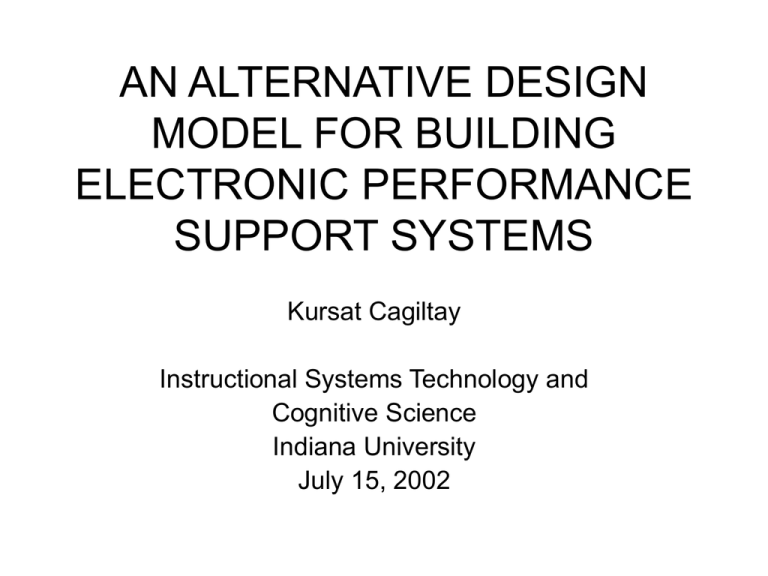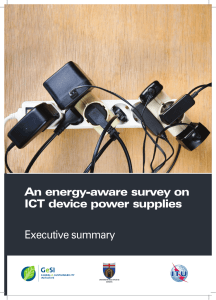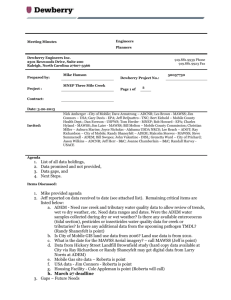Document
advertisement

AN ALTERNATIVE DESIGN MODEL FOR BUILDING ELECTRONIC PERFORMANCE SUPPORT SYSTEMS Kursat Cagiltay Instructional Systems Technology and Cognitive Science Indiana University July 15, 2002 What is EPSS? • EPSS is – a computer based (electronic), – user controlled and easy to use system that provides support at the moment it is needed (right time), – presents relevant (right type) and – context-focused (right amount) information that the performer needs, – in the real work environment (right place) • Components of EPSS – – – – Database Tools Instructional component Expert system Why do we need a D/D model? • EPSSs are significantly different from instructional systems. – Main focus is performing rather than learning – EPSS is used while doing the actual job, not beforehand – No need to follow a predetermined sequence • Especially the focus on the "work process" makes the design and development of an EPSS quite different than the traditional models of instructional design. (Witt & Wager, 1994; Cole et al.,1997; Cote, 2000) • There is a broad consensus that there is a lack of EPSS design and development models (Gustafson, 1993; Gustafson, 2000; Milheim, 1997; Laffey, 1995; Rosenberg, Coscarelli & Hutchison, 1999) Research Questions • Given that the traditional models of instructional development are inappropriate for EPSS development, what are the primary distinctive characteristics of an effective and efficient EPSS design and development process? • What should an effective and efficient design model incorporate for the development of an effective and efficient EPSS? Methodology • Multiple case studies • Formative research methodology (Reigeluth & Frick, 1999) – Naturalistic case study – Cases are not specifically designed according to the theory – Cases are analyzed to see the failing points and valuable elements • Two major types of naturalistic formative research procedures – “In vivo” (during the process) and – “Post facto” (after the process) • Research process Select several cases collect and analyze data on the cases fully develop a tentative model Methodology • Cases – A higher educational setting (in-vivo, postfacto) – A car manufacturing company (post-facto and in-vivo) – A telecommunications company (in-vivo) Methodology • Data collection – Observations • In-vivo only – Interviews • D/D team members, end-users, managers – Document Analysis • Web-sites, reports, e-mail logs, proposals • Data Analysis – Continuous and iterative – Explored similarities and differences among the cases – Looked for: social, political and technical aspects of the EPSS design/development, and process related issues Results: The Underlying Principles of the Model • Principles related to social issues 1. Identify and develop awareness and need for EPSS 2. Understand political/cultural characteristics and history of the organization and the stakeholders 3. For active involvement establish good communication strategies 4. Explore and create mechanisms to increase motivation for active involvement Results: The Underlying Principles of the Model • Principles related to technical issues 5. Form a team with technically competent members 6. Focus on compatibility, portability and standardization of the EPSS 7. Make early decisions about the best technology needs 8. Design a seamless Performer-EPSS-Interaction environment (Human-Computer-Interaction) 9. Manage content and information overflow 10. Get help from the Information Systems discipline Results: The Underlying Principles of the Model • Principles related to process issues 11. Follow a dynamic EPSS design/development process 12. Form a multi-skilled/multi-disciplined team 13. Create shared vision and make sure everybody believes it 14. Forecast risks in advance and develop a risk management mechanism Two general patterns were observed 1. Cases were developed for complex sociotechnical organizational environments, and the D/D processes have shown a dynamic nature. 2. Throughout the entire D/D process, the team members had to make changes and revisions of their plans to overcome problems: adaptive The proposed EPSS D/D model is based on the 14 principles. It reflects these two patterns and received its name from them: Adaptive Dynamic EPSS Model: ADEM • ADEM includes – people/organization, – the technology that supports them, and – the processes that tie them all together with an emphasis on peopleware (soft) issues • The focus was more on the generic design process, with the major components that reflect the patterns of design activities carried out by EPSS designers in the field. • The ADEM is a framework for portraying overall EPSS design and development. Shows more descriptive model characteristics than a step-bystep, prescriptive one Two Foundations of the ADEM • The development of the ADEM was helped by Chaos Theory. – Kellert (1993) defines Chaos Theory as, “qualitative study of unstable aperiodic behavior in deterministic nonlinear dynamical systems” (p. 2) • Information System (IS) development and EPSS development have many similarities, so if one side of the ADEM stands on Chaos Theory, the other side is based on the IS discipline Conceptual Elements of Chaos • Sensitive dependence on initial conditions • Fractals: Fractal implies recursion, patterns inside of patterns (feedback between parts or levels of the system ) • Strange Attractors (choices of behavior) • It (and ADEM) originates from nature • How? Visual representation of the ADEM inspired from fractal geometry Mandelbrot-Julia set fractal Recursion: Patterns inside patterns Mandelbrot-Julia set fractal ADEM: General Process Layout ADEM: Feedback Mechanism • Classical negative feedback mechanisms makes the system resistant to change • ADEM has a positive feedback mechanism or the learning loop approach – Such loops make a system open to change – The growth of knowledge during the overall process makes learning loops or positive feedback possible The Process of the ADEM • Through increments of several iterations • Increments occur concurrently • Change is seen to be normal • Time or schedulebased phases: time-boxing Task-1 Task-2 Task-3 Task-4 Task-n Time Adapted form Highsmith (2000) Time-Boxes • ADEM approaches the D/D process with a timeline lifecycle policy (time-boxing). • Major time-boxes are: – Pre-project time-box: Feasibility, speculation – Take-off time-box: Planning & Design – Rising time-box: Development – Destination time-box: Implementation & maintenance Pre-project time-box • Feasibility – Mindset study – Speculation – Methodological decisions – Is EPSS the right solution? Go, no-go. • Major Outcomes – Vision statement – Risk management plan • Major issues – Organization type, support, motivation mechanisms, communication, vision, risks, technology, information resources Take-off time-box • Analysis & Design – Functional & structural requirements of the EPSS are determined – Analysis framework uses Checkland’s SSM CATWOE analysis – Based on the analysis, activities and timeboxes are determined. Time mgmt. policy! • Major issues – Organizational environment, iterative process, participatory design, technical decisions, multiple perspectives, positive feedback Rising time-box • Development – Based on the blueprint of the previous stage – “Concurrent component engineering” – Incorporates multiple perspectives (social, technical, organizational) – Results driving approach (goal: quality products) – Development is not finished - it evolves • Major issues – Multidisciplinary collaboration, short cycles, learning from mistakes, active participation Destination time-box • Implementation – Moving to real-life environment – Input from more and more users – Analysis and design still continue – “As soon as the design is implemented, its consequences indicate the need for redesign” Cherns (1976) – Weakest part of the ADEM – No cases reached it • Major issues – Political and cultural issues, communication, reward mechanisms Model Summary Methodology Adaptive & Dynamic, Socio-Technical People All of the actively participating stakeholders Team Multidisciplinary Environment Complex Process Product-oriented, concurrent, iterations with increments Change Continuous, learning-based Evaluation Parallel to activities, continuous testing, positive feedback Management Timeboxing, Risk management, Vision-based Technology Standard, compatible, suitable Discussion • Is it safe to use the ADEM? – Answer is Yes: Needs good planning and careful work • Does it need more work? – Answer is Yes: Needs to be critically evaluated and improved • Hard to use it? – Yes, but simple solutions work for simple problems • The model itself needs to be improved in dynamic and adaptive way Limitations • Three cases were investigated • Identifying the underlying detailed steps of the ADEM was beyond the scope of this study. They can be addressed in future studies • The principles are tentative, guidelines are not widely tested, and the model has not been applied in any real case Future Research • Further research on Chaos Theory is needed for EPSS D/D. • A strong bridge definitely should be established between IS and EPSS research. • Detailed guidelines need to be developed for the phases and the implementation phase needs to be made clearer Questions?









